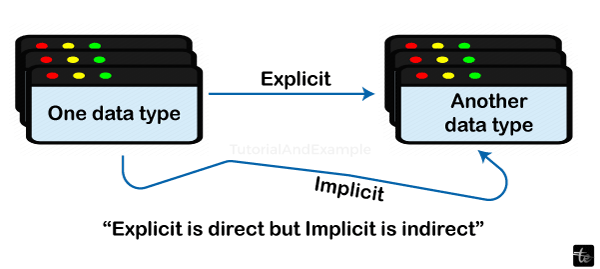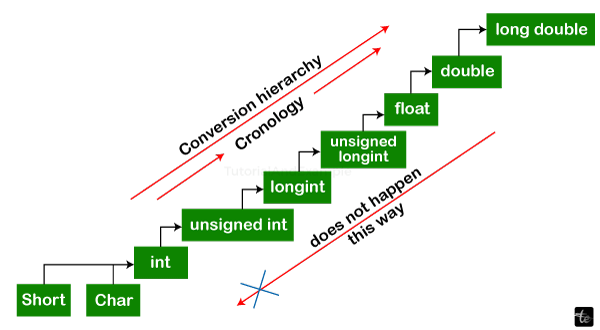Implicit Type Conversion Example
Implicit Type Conversion Example
Definition of Implicit Type Conversion
Type conversion is another process in which a compiler or an interpreter converts a given data type into another data type; it is largely based on the process of type coercion. This makes it possible to have a function operate on another function; array, list, and the like without having the programmer provide the instructions. Casting from one type to another arises commonly in various programming languages and forms a base in the integration of any data set in expressions and functions.
More specifically, implicit type conversion takes place when one encounters an operation that uses more than one differing data type. The compiler or the interpreter then selects the type with the higher degree of generality and assigns the less general type to that of the selected higher type. It helps to prevent complications due to type mismatch this implies that operations will run normally without considering the type of data that is being used. For example, if there is an integer and a float, the integer might be converted into to float to provide accurate and consistent results in case of some calculations.
There is a variety of approaches to how programming languages handle implicit type conversion for them. In some languages, such as the C and C++ languages, this is called type promotion. Here, scaled integer types, such as char and short, will be automatically integrated into bigger types like int or float if they are to be used in any expressions. Widening conversions occur in Java, like when a small data type is used in an expression where a large data type is expected. In mixed-type operations, a type of operation that can potentially lead to the implicit conversion of one type to another, Python is relieved by its dynamic typing system to seamlessly give way, integers, for instance, to floats.

Importance in Programming
The process of type conversion, which is also termed type coercion, is a vital mechanism in programming and has added more proficiency and versatility to the language. This makes data type conversion easier for a programmer to develop this code since they do not have to struggle to make different types of data in one form before carrying out a certain operation.
The second capability that is tied directly to implicit type conversion is the possibility to perform arithmetic and logical operations on the values of the different types. For instance, if an operation involves an integer and a float value, the integer is automatically converted to float by JDBC through implicit type conversion. This means that errors tied to specific types will not occur, and computation can go on uninterrupted, giving good results. Such automatic conversions are most useful when working in a large application; otherwise, the conversion of types takes much time and can also be done with errors.
Also, one aspect originates from implicit type conversion, which improves code readability and maintainability. This is especially helpful in terms of minimizing the need for the client to cast the data type itself, thus making the code less cluttered or key. This is particularly useful when several developers are reviewing a certain particular file at the same time. Code which relies on implicit type conversion is desirable since it simplifies code management because fundamental type management concerns are managed implicitly.
Another emerging feature relates to the amendment of code interaction whereby different codes interact better with each other than before. Libraries do exist in contemporary software development environments to provide developers with functionalities that they need in various projects, and these can contain different data types. This is because implicit type conversion provides the necessary means of mediating the interactions between such components, with reference to the fact that the type mismatches involved can always be implicitly coerced. This ensures that the data type and functions/method from different sources can coexist and use each other seamlessly without a lot of type checking.
Indeed, even in languages like Python and JavaScript, which are considered to be dynamically typed, IT conversion also partly participates in the expression of actual types. In these languages, variables can store values of any type, and implicit type conversion is used to enable change of variable types at runtime. This feature is particularly suitable for scripting, nonzero prototyping, or applications where the data type beforehand may not be easily predetermined.

C/C++
Implicit Conversion in Arithmetic Operations
In C/C++, implicit conversion in arithmetic operations occurs when operands of different types are involved in a computation. The compiler automatically converts one operand to the other to facilitate the operation.
Promotion of Integer Type
Promotion of integer types involves converting smaller integer types (like char, short) to larger integer types (like int) when they are used in expressions. This process is known as integer promotion.
Example in C
#include <iostream>
using namespace std;
int main() {
int intVar = 5;
double doubleVar = 2.5;
double result = intVar + doubleVar;
cout << "Result: " << result << endl;
return 0;
}
Output:
Result: 7.5
Explanation
In this example, intVar is of type int and doubleVar is of type double. When performing the addition operation (intVar + doubleVar), the int operand is implicitly converted to double. Hence, intVar (5) is converted to 5.0, and the result of the addition is 7.5. The final result, stored in result, is of type double.
Example
#include <iostream>
using namespace std;
int main() {
char charVar = 100; // char is usually promoted to int
int intVar = 200;
int result = charVar + intVar;
cout << "Result: " << result << endl;
return 0;
}
Output:
Result:300
Explanation:
In this example, charVar is of type char and intVar is of type int. When the addition operation (charVar + intVar) is performed, charVar is implicitly promoted to int. This means charVar (which holds the value 100) is treated as an integer during the addition, resulting in 100 + 200 = 300. The result is stored in the int variable result.
Conversion between Floating-Point and Integer Types
Conversion between floating-point and integer types occurs when a floating-point value is assigned to an integer variable or vice versa.
Example:
#include <iostream>
using namespace std;
int main() {
double doubleVar = 9.99;
int intVar = doubleVar; // Implicit conversion from double to int
cout << "intVar: " << intVar << endl;
return 0;
}
Output:
intVar:9
Explanation
In this example, doubleVar is of type double and holds the value 9.99. When doubleVar is assigned to intVar, an implicit conversion occurs. The floating-point value 9.99 is truncated (not rounded) to the integer value 9, which is then assigned to intVar. Thus, intVar holds the value 9, and this value is printed to the console.
Java
Widening Primitive Conversion
In Java, widening primitive conversion occurs when a smaller data type is automatically converted to a larger data type during certain operations.
Example in Java
public class Main {
public static void main(String[] args) {
int intVar = 5;
double doubleVar = intVar; // Widening conversion from int to double
System.out.println("doubleVar: " + doubleVar);
}
}
Output:
doubleVar:5.0
Explanation:
In this example, intVar is of type int and holds the value 5. When intVar is assigned to doubleVar, a widening conversion occurs, where the int value is automatically converted to a double. This results in doubleVar holding the value 5.0, which is then printed to the console.
Automatic Conversion in Expressions
In Java, automatic conversion occurs in expressions involving mixed data types, where the compiler automatically promotes smaller data types to larger ones.
Example
public class Main {
public static void main(String[] args) {
int intVar = 10;
double doubleVar = 3.5;
double result = intVar + doubleVar; // Automatic conversion of int to double
System.out.println("Result: " + result);
}
}
Output:
Result:13.5
Explanation
In this example, intVar is of type int and doubleVar is of type double. When performing the addition operation (intVar + doubleVar), the int operand is automatically promoted to a double. Hence, intVar (10) is converted to 10.0, and the result of the addition is 13.5. The final result, stored in result, is of type double.
Python
Implicit Conversion in Dynamic Typing
In Python, implicit conversion occurs in dynamic typing, where variables can hold values of any type, and the interpreter automatically converts between types as needed.
Example in Python
intVar = 5
floatVar = 2.5
result = intVar + floatVar # Implicit conversion of int to float
print("Result:", result)
Output:
Result:7.5
Explanation
Here, the variable intVar is initialized with an integer response of 5, and floatVar with a floating-point value 2. 5. In performing the addition operation (intVar + floatVar), the int type operand is promoted to float. Therefore, the variable intVar holding 5 is converted to 5. It is 0 when added to the moving average, and the result of addition is 7. 5. The last value of the program is of data type – float.
Mixing Integers and Floats
Python also allows mixing integers and floats in arithmetic operations without explicit conversion, as the interpreter handles conversions automatically.
Example in Python
intVar = 10
floatVar = 3.5
result = intVar + floatVar # Mixing int and float without explicit conversion
print("Result:", result)
Output:
Result:13.5
Explanation
In this example, intVar holds the integer value of the number 10, and floatVar contains the float value of the number 3. 5. In the process of adding the type with floatType of the operand (intVar + floatVar), the int is promoted to a float. Therefore, intVar (10) is changed to 10. The first number in the addition instance is 0, and the result of the addition is 13. 5.
JavaScript
Type Coercion in Expressions
JavaScript employs type coercion, where operands of different types are converted to a common type before performing operations.
Example
let intVar = 5;
let stringVar = "2";
let result = intVar + stringVar; // Type coercion: intVar is converted to string
console.log("Result:", result);
Output:
Result:52
Explanation
In this case, intVar is an instance of an integer with a value of 5, while stringVar is a string that has a value of “2”. This means that during the operation of adding intVar to the stringVar, the value is implicitly converted to match the type of stringVar, and intVar is converted to stringVar, after which a concatenation is done. Therefore, the string “52” is printed out to the console as the final result of the given code fragment.
Conversion in Comparisons
JavaScript also performs automatic conversion in comparisons, where operands of different types are coerced to a common type before comparison.
Example
let numVar = 10;
let strVar = "5";
console.log(numVar > strVar); // Comparison: strVar is converted to a number
Output:
true
Explanation
As in the first case, ‘numVar’ is assigned the numeric value of 10 while the ‘strVar’ is assigned the string value of 5. When comparing numVar to strVar specifically, where numVar > strVar, JavaScript converts the content of the variable strVar to a number type. Therefore, when the second condition is compared to the third – 10 with 5 – the overall statement yields a positive result.
Potential Pitfalls
Best Practices
Conclusion
In conclusion, you will see that implicit type conversion is a critical feature of any seriously considered programming language while encouraging easy data processing and expression evaluations. Now, let us discuss the examples of implicit conversion that take place in numbers operations, data assigning, and comparisons in different programs written in different programming languages. Although implicit type conversion is highly beneficial for the improvement of code readability and reducing the number of syntactical lines, one must know its functionality and its drawbacks. With explicit type declarations whenever this is required, usage of type annotations and testing, the ORP allows one to make intelligent use of this feature so that the code is clear, reliable and maintainable.